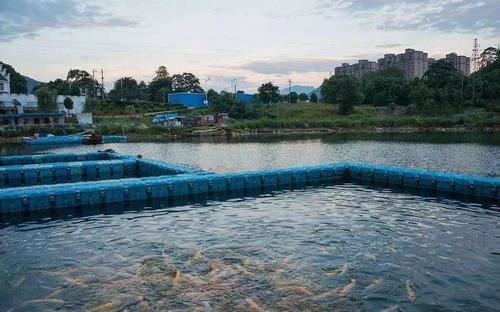News
How much do you know about dissolved oxygen in aquaculture ponds?

Source of dissolved oxygen in water
The dissolved oxygen in water mainly comes from the photosynthesis of algae and aquatic plants in the water. Strictly speaking, oxygen is the by-product of the carbon reduction process of photosynthesis. CO2+H2O→CH2O+O2。 More than 60% of dissolved oxygen in water comes from algae, which requires the necessity of reasonable algae cultivation in the process of aquaculture
Infiltration of oxygen in the atmosphere.Such as wind blowing, start the aerator, water flow, etc
Consumption of dissolved oxygen
The consumption of dissolved oxygen in the water body mainly depends on the respiration of algae, aquatic plants, breeding objects and microorganisms in the water body, as well as the decomposition of organic matter in the feces of residual bait at the bottom of the pond.
Hazards of excessive dissolved oxygen
Too high dissolved oxygen will lead to too high oxygen pressure in the water body. Too high oxygen pressure will cause "oxygen poisoning" to the breeding animals, especially the breeding objects of juveniles, which will cause bubble disease. At the same time, generally speaking, too high dissolved oxygen indicates that the amount of algae in the water body is too large, and the distribution of algae phase is abnormal, so it is easy to pour algae in this changing weather. High dissolved oxygen can produce a large number of free radicals, which can damage many organs of the body of breeding objects. Under the environment of high dissolved oxygen, the accelerated metabolism of newly formed algae is likely to cause rapid aging of algae, accelerate the death of algae, cause rapid hypoxia in the breeding pond, and cause the death of breeding animals
Hazards of insufficient dissolved oxygen
Insufficient dissolved oxygen can affect pond culture from both animal and environmental aspects
Animal aspect
① Direct death. When the dissolved oxygen is lower than the minimum tolerance concentration of cultured animals for a period of time, it can directly lead to the suffocation of cultured animals.
② Non fatal injury. When fish and shrimp are seriously anoxic for a short time, they will not die, but they will also be seriously injured.
③ Impaired immune function. In the low dissolved oxygen environment, the immune function will be damaged and become more sensitive to the invasion of pathogenic microorganisms.
④ The ability to resist adversity decreased. The lack of dissolved oxygen can lead to the breeding animals becoming more sensitive to environmental change conditions such as pH change, temperature change and salinity change.
⑤ Digestion and absorption efficiency decreased. The digestibility and assimilation ability of fish and shrimp to feed is directly proportional to the concentration of dissolved oxygen. Within a certain range, the higher the concentration of dissolved oxygen, the higher the ability of digestion, absorption and assimilation. Therefore, the demand for oxygen in the pond will increase with the decrease of dissolved oxygen concentration.
Environmental aspects
① It leads to the change of microbial ecological composition. In nature, microorganisms are distributed in a redox gradient. The microbes adapted to different rongo concentrations were different. Therefore, the change of dissolved oxygen concentration will lead to the change of microbial population.
② Resulting in an increase in pond oxygen demand. Low dissolved oxygen leads to the decline of digestion and absorption capacity of fish and shrimp, resulting in more feed waste. Therefore, more dissolved oxygen is required for treatment.
③ This leads to the decline of pollution purification capacity. The rate of microbial oxidation of organic matter is proportional to the concentration of dissolved oxygen. Low dissolved oxygen concentration increases the pollution rate on the one hand, and reduces the purification speed on the other hand. Therefore, low dissolved oxygen will easily cause rapid accumulation of pollutants and greatly reduce the pollution bearing capacity of the pond. Cause degradation, aging and deterioration of water quality.
④ It leads to the increase of pathogenic microorganisms. Almost all pathogenic microorganisms of aquaculture animals are facultative anaerobes.. When dissolved oxygen is insufficient, aerobic microorganisms lose their competitive advantage and facultative anaerobic microorganisms gain opportunities.
⑤ Increase in toxic and harmful substances. Low dissolved oxygen will lead to the production of reducing substances such as hydrogen sulfide, ammonia nitrogen, sub salt and other harmful substances.
I have been engaged in aquatic work for several years. I found that in the past twoorthree years, the breeding bosses have paid more and more attention to the dissolved oxygen in the pond, but they all judge whether the pond is lack of oxygen based on traditional experience. For example, the fish are floating, the sky is stuffy, or they habitually turn on the aerator around 9 p.m. in recent years, even if the aerator is turned on, the pond is still in a state of lack of oxygen. Why? The aerator and other equipment are used to prevent anoxia, but most of the time they are used for emergency rescue. When the pond is already anoxic, it is very limited to open the aerator to increase the dissolved oxygen in the pond. When is the pond anoxic? When is there no lack of oxygen? In fact, many bosses can't tell the difference. As a result, opening the aerator of the aerator has become more blind. It's never clear whether the pond is lack of oxygen. In the era of more and more data-based breeding, you can consider installing a Y23 intelligent detection device to monitor the change of dissolved oxygen in the pond for 24 hours to let you know the indicators of the pond.
Welcome to contact:+8618013418091(Whatsapp/Wechat)
+8618013418097(Whatsapp/Wechat)
 Alvin
Alvin hugh778
hugh778